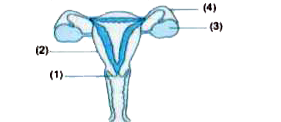In Australian Acacia, petiole is modified into leaf like sickle shaped structure known as
Phyllode
Phylloclade
Cladode
Hypsophyll
The correct Answer is:A
Step-by-Step Solution:
1. Understanding the Question: The question asks about the modification of the petiole in Australian Acacia, specifically what this modified structure is called.
2. Identifying the Structure: In Australian Acacia, the petiole (the stalk that attaches the leaf blade to the stem) is modified into a structure that resembles a leaf. This structure is known for its sickle shape.
3. Function of the Modified Structure: The modified petiole, which takes on the leaf-like appearance, plays a crucial role in photosynthesis. This is significant because the original leaf lamina may fall off quickly, leaving the petiole to perform the photosynthetic function.
4. Naming the Structure: The modified petiole in Australian Acacia is called a "phyllode." Phyllodes are typically flattened and leaf-like, allowing them to carry out photosynthesis effectively.
5. Additional Characteristics: Phyllodes usually develop vertically and possess stomata, which are small openings that allow for gas exchange. This enables not only photosynthesis but also transpiration, which is the process of water movement through a plant.
6. Comparison with Other Terms: It is important to differentiate phyllodes from other terms:
- Phylloclade: A modified branch that resembles a leaf.
- Cladode: A stem that is flattened and functions like a leaf.
- Hypsophyll: A bract or bractiol associated with flowers.
7. Conclusion: Based on the understanding of the modifications and their functions, the correct answer to the question is that the modified petiole in Australian Acacia is called a "phyllode."
Final Answer: Phyllode
---
- Phylloclade: A modified branch that resembles a leaf.
- Cladode: A stem that is flattened and functions like a leaf.
- Hypsophyll: A bract or bractiol associated with flowers.
Similar Questions
Answer question on the basis of your understanding of the following paragraph and the related studied concepts :
(i) When a girl is born, the ovaries already contain thousands of immature eggs
(ii) On reaching puberty, some of these start maturing. One egg is produced every month by one of the ovaries.
(iii) The egg is carried from the ovary to the womb through a thin oviduct or fallopian tube.
(iv) The two oviducts unite into an elastic bag-like structure known as the uterus.
(v) The uterus opens into the vagina through the cervix.

What is the site of fertilisation ?
View SolutionIn Venus-fly-trap,the leaf is modified into special structures to
View Solution
Knowledge Check
The petiole modified into leaf like structure is known as
APhyllocladeBPhyllodeCCladodeDCladophyllPetiole is modified into green leafy structure called
APhyllodeBPhyllocladeCCladodeDFoliaceous petiole.Wall of colon has sac like structures known as
AHaustraBTaenia coliCEpiploic appendagesDAppendix
Petiole part of the leaf is known as
View SolutionStem modified into leaf like structure and leaves are changed into spines in -
View SolutionAssertion :- Petiole modifies into leaf like structure in phyllode.
Reason :-Phyllode does not perform photosynthesis.
View SolutionWhich of following has a clover leaf shaped structure?
View SolutionModification of petiole into leaf-like structure is called
View Solution
